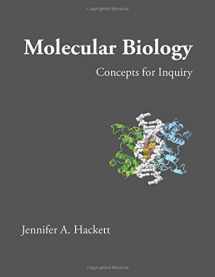
Molecular Biology: Concepts for Inquiry
Book details
Summary
Description
This introductory college-level molecular biology textbook builds upon concepts from first-year high school biology and chemistry courses to elucidate essential concepts in molecular biology, biochemistry, cell biology, and genetics. It is appropriate for college courses and high school courses taught at the college level. Over 170 color figures clearly illustrate key concepts. The goal of this work is to clarify concepts in a streamlined manner, not to be an encyclopedic collection of facts. Connections are explicitly made to prior knowledge and key high school chemistry concepts are reviewed. The biotechnology driving basic science research and translational medicine is explained so that this textbook can serve as a companion to a student beginning molecular biology research. Highlighted techniques include PCR, Sanger DNA sequencing, next-generation DNA sequencing, genetic engineering of plasmids, iGEM gene assembly, principles of gene expression, gene transfer into bacteria and mammalian cells, strategies in drug design, human gene therapy, CRISPR and other genome editing techniques. Human disease is explored from the standpoint of understanding its basic science in order to develop effective treatments.
This textbook was created to replace direct lecturing, to support teaching through inquiry and experimentation. Supporting materials available in Molecular Biology Concepts for Inquiry: The Exploration Workbook, Molecular Biology Concepts for Inquiry: A Guide to Inquiry and on the author's website: HackettMolecularBiology.blogspot.com. This supporting curriculum can be readily adapted for remote online learning.
CHAPTER 1: INTRODUCTION TO BIOCHEMISTRY AND CELL BIOLOGY: Organic Molecules; The Thermodynamics of Life; Organic Molecules and Thermodynamics in the Cell; Biotechnology and Alternative Energy.
CHAPTER 2: PROTEIN STRUCTURE AND FUNCTION; Protein Biochemistry; Enzyme; Use and Manipulation of Proteins in Biotechnology.
CHAPTER 3: DNA REPLICATION, REPAIR AND GENETIC ENGINEERING; Chromosomes; DNA Biochemistry; DNA Replication; DNA Repair Enzymes; Genetic Engineering.
CHAPTER 4: THE REGULATION OF GENE EXPRESSION: The Regulation of Transcription; The Organization of a Gene; Posttranscriptional Regulation of mRNA Levels in Eukaryotes; The Programming of Transcriptional Patterns During Development; Measuring Levels of Gene Expression.
CHAPTER 5: GENOME EVOLUTION: Genome Evolution; Cancer; Mutation and Selection in the Immune System.
CHAPTER 6: EMERGING MOLECULAR BIOLOGY, BIOTECHNOLOGY AND MEDICINE: Precision Medicine: Analyzing Individual Genomes and Transcriptomes; Emerging Methods for Disease Treatment.
REFERENCES
INDEX (paperback)
SELECT TOPICS INCLUDE: Mechanisms of dominant (gain of function, dominant negative, haploinsufficiency) and recessive phenotypes, protein misfolding, prion disease, PCR, cohesin in mitosis, Sanger and next gen DNA sequencing, DNA fingerprinting, mutation and DNA repair, NHEJ, homologous recombination, restriction enzymes, cloning strategies, gene transfer, gene parts, mRNA stability, euchromatin and heterochromatin, histone modifications, chromatin packaging, topologically associated domains, organismal cloning, stem cells, DNA methylation patterns, genomic imprinting, X chromosome inactivation, RNAi, siRNA, microRNA, lncRNA, microarrays, patterns of conserved synteny in genomes, natural selection of phenotypes in genome evolution, gene duplication, hallmarks of cancer, Knudson's 2-Hit Hypothesis, tumor suppressor genes, oncogenes, cancer mutations in signaling pathways, cell cycle checkpoints, telomeres and telomerase, p53, mitotic errors in chromosome segregation, causes of genomic instability in cancer, VDJ rearrangement and selection, precision medicine, genome or exome sequencing, gene therapy, genome editing, TALENs, CRISPR/Cas9, drug design, molecular dynamics modeling in drug design.


We would LOVE it if you could help us and other readers by reviewing the book
Book review



